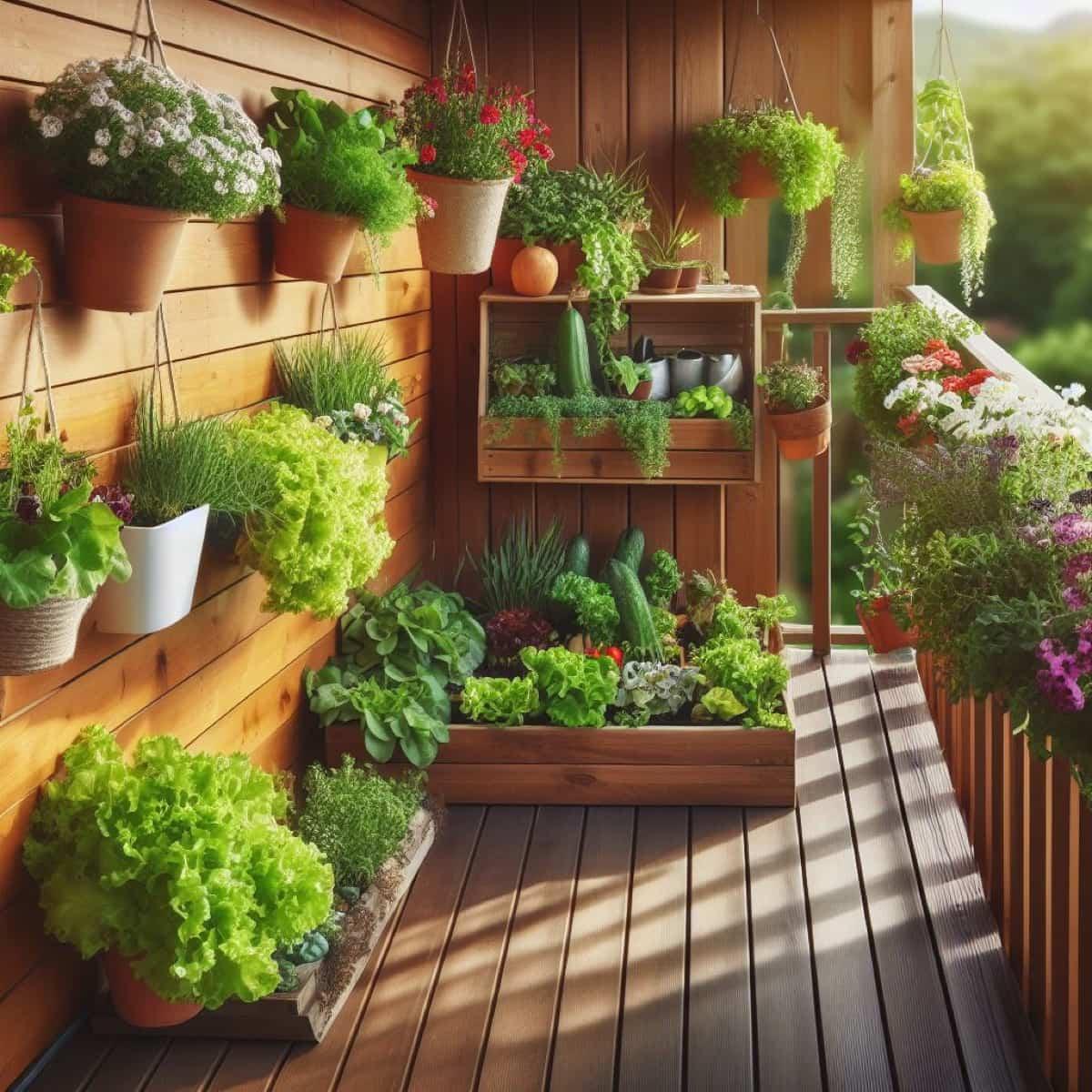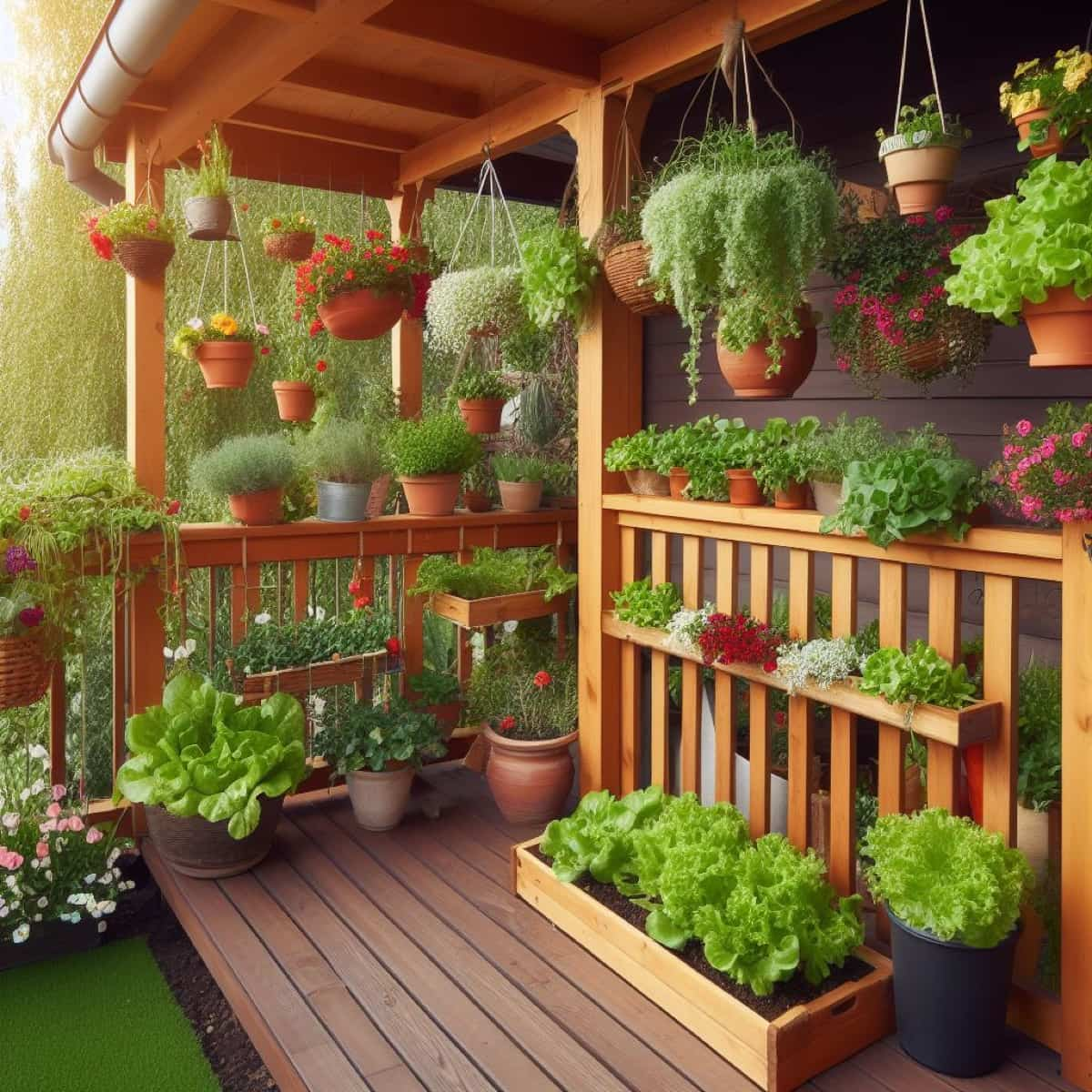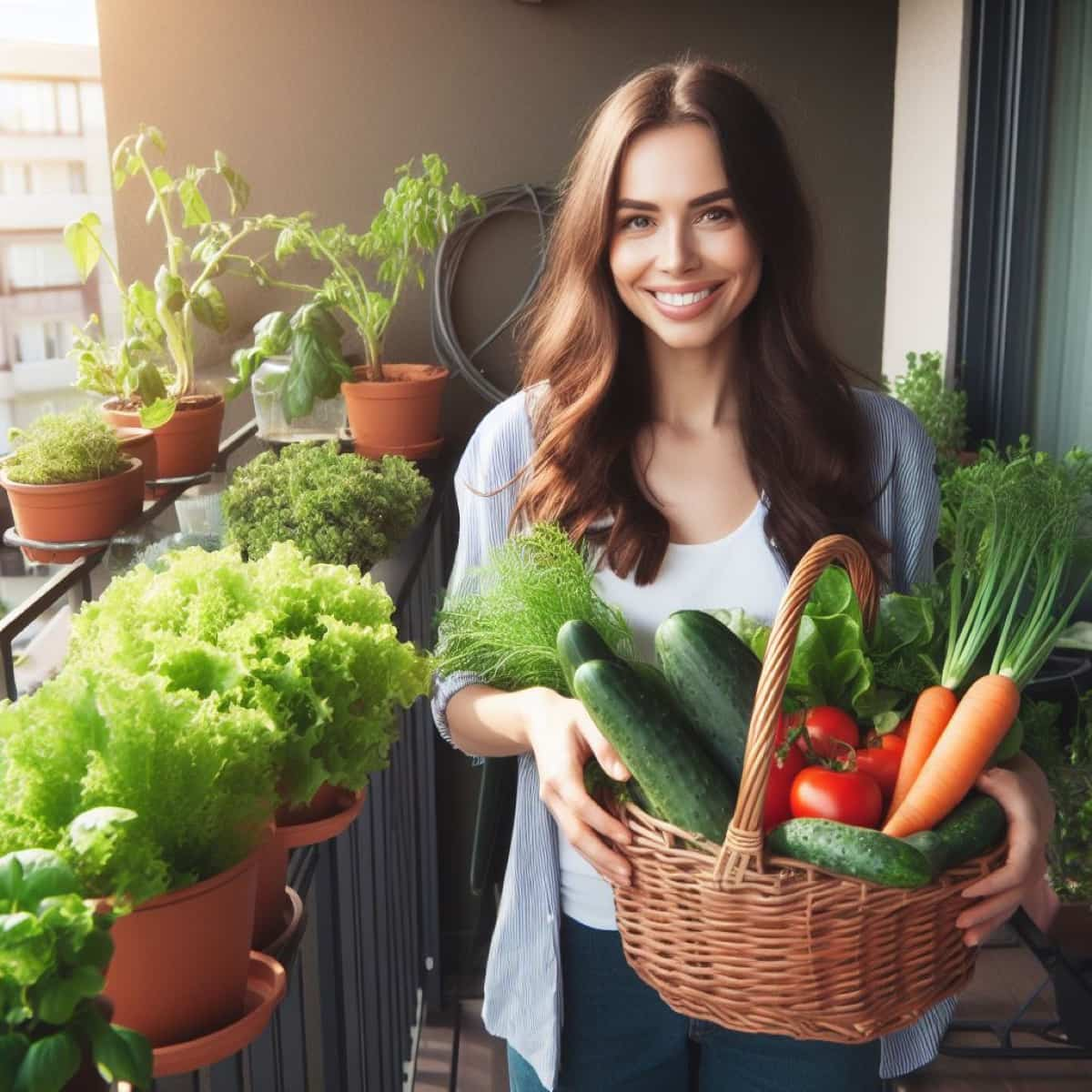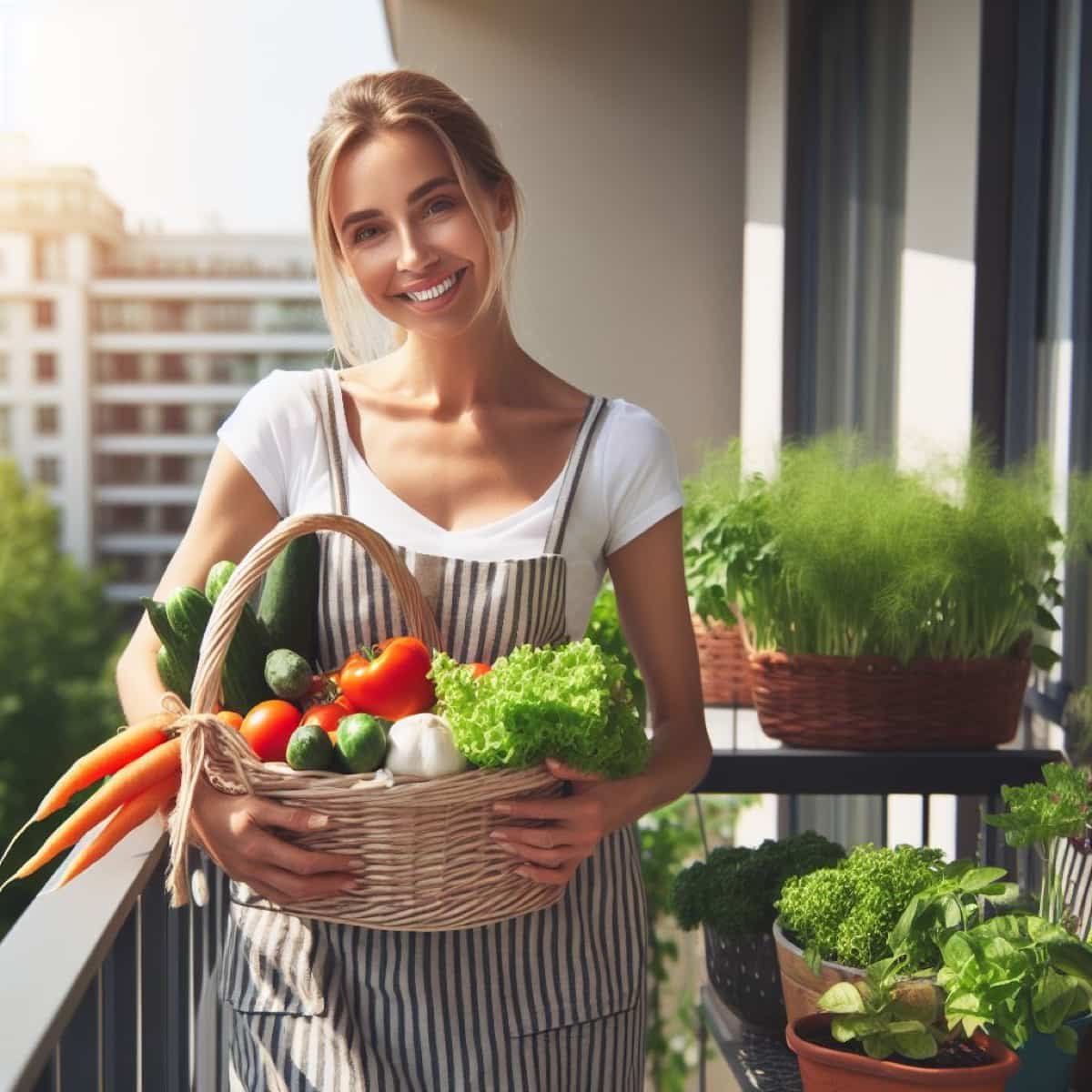A small balcony shouldn’t limit your gardening ambitions. Creativity and careful planning can transform the tiniest space into a flourishing vegetable garden. By taking advantage of vertical space and choosing the right plants, you can create an oasis of greenery outside your door. A balcony vegetable garden offers numerous benefits, such as providing fresh produce, reducing stress levels, and adding visual appeal to your outdoor living area. It allows you to connect with nature and enjoy the satisfaction of growing your food.

Creative Ideas for Small Balcony Vegetable Gardens
Choosing the Right Vegetables for a Small Balcony Garden
| Leafy Greens | Lettuce, Spinach, Kale, and Swiss Chard are great for small spaces as they can be grown in shallow containers and have a relatively fast growth cycle. |
| Herbs | Basil, Parsley, Mint, and Cilantro are perfect for adding flavor to your meals and can easily be grown in pots or hanging baskets. |
| Tomatoes | Compact varieties like Cherry Tomatoes or Patio Tomatoes thrive in containers and produce an abundant crop throughout the summer. |
| Peppers | Bell Peppers or Chili Peppers can be grown successfully on balconies with adequate sunlight and regular feeding. |
| Radishes | These fast-growing root vegetables are ideal for small spaces due to their compact size and quick maturation. |
| Beans | Pole Beans or Bush Beans can be trained up trellises or allowed to cascade over railing planters, making them suitable for vertical gardening. |
| Carrots | Choose shorter varieties that don’t require deep soil, such as Parisian Carrots or round Baby Carrots. |
Utilizing Vertical Space for Maximum Yield
Utilizing vertical space is a smart way to maximize the yield of a small balcony garden. Hang or attach planters to walls or railings to create a living wall of greenery. You can use fabric pockets, modular systems, or repurpose old shoe organizers. Set up tiered shelving units to display potted plants at various heights. This allows you to utilize both the floor space and the vertical height of your balcony.
Grow climbing vegetables like Tomatoes, Cucumbers, and Beans by providing them with support structures such as trellises or cages attached to walls or railings. Hang baskets from hooks on the ceiling or railing to add another level of growing space for trailing plants like Strawberries or herbs. Install window boxes outside your windowsills for growing herbs, Lettuce Greens, or small flowers without taking up valuable floor space.
Container Gardening Techniques for Small Balconies
When it comes to small balcony gardens, container gardening is a game-changer. It allows you to maximize your limited space while still enjoying the benefits of growing your vegetables. The key is choosing the right containers and implementing effective techniques to ensure success. Opt for lightweight and portable containers like plastic or fabric pots. They are easy to move around and can be stacked when not in use. Make sure each container has drainage holes at the bottom to prevent waterlogging.
In case you missed it: 13 Practices for Sustainable Balcony Vegetable Gardening

Consider vertical gardening techniques such as using trellises or hanging baskets. These methods help you maximize your vertical space while adding visual interest to your balcony garden. Planting different types of vegetables together in one container. This technique maximizes space utilization and promotes companion planting benefits. Additionally, try succession planting by staggering the sowing dates of various crops.
Moreover, utilize tiered shelving units or plant stands to create multiple layers for growing plants in smaller spaces. You can also hang plants from railing brackets or wall hooks for added greenery. Don’t forget about proper watering and fertilizing techniques specific to container gardening. Since containers tend to dry faster than traditional soil beds, regular watering is necessary, but avoid overwatering, which causes root rot.
Creative Planting Ideas for Limited Space
| Vertical Gardening | Utilize wall space by installing vertical garden systems or hanging pots to grow plants like strawberries, herbs, and small vegetables. |
| Tiered Planters | Opt for tiered planters or shelves to maximize planting space vertically. |
| Window Boxes | Install window boxes outside your balcony railing to add extra growing space for flowers, herbs, or even compact veggies like Cherry Tomatoes. |
| Hanging Baskets | Hang baskets from the ceiling or railing filled with trailing plants such as Cherry Tomatoes, cascading flowers, or vine-like vegetables like Cucumbers. |
| Trellises and Mesh Netting | Attach trellises or mesh netting against a wall to support climbing plants like Beans, Peas, Cucumbers, and even small melons. |
Incorporating Herbs and Edible Flowers in a Balcony Garden
Incorporating herbs and edible flowers in a balcony garden is practical and adds beauty and flavor to your space. Herbs can be used in cooking, teas, or even for their medicinal properties. Edible flowers, on the other hand, bring a pop of color and unique flavors to your dishes. When choosing herbs for your balcony garden, consider compact ones that don’t require much space to thrive.
In case you missed it: Top 12 Attractive Foliage Plants for a Sunny Balcony Garden

Some popular options include Basil, Mint, Parsley, Chives, and Thyme. These herbs can easily be grown in containers or hanging baskets. Edible flowers like Nasturtiums, Pansies, Calendula, and Lavender look stunning and provide an array of flavors that can enhance salads or desserts. It’s important to ensure you’re using organic varieties specifically labeled as edible.
Creating a Mini Greenhouse on Your Balcony
Creating a mini greenhouse can be an excellent solution if you have limited space on your balcony but still want to grow various vegetables. A mini greenhouse allows you to protect your plants from harsh weather conditions. To create a mini greenhouse, choose the right structure for your space. You can opt for a small portable greenhouse or even repurpose old shelving units with plastic sheeting as covers.
The key is to find something that fits seamlessly into your balcony layout. Next, consider the positioning of your mini greenhouse. Place it in an area where it receives ample sunlight throughout the day. This will ensure optimal growth for your plants. Once you’ve set up the structure, consider regulating the mini greenhouse’s temperature and humidity.
Ventilation is crucial, so ensure some openings or vents allow air circulation while preventing overheating. Monitoring moisture levels is important for successful plant growth in a miniature environment like this. Consider using trays filled with water or installing misting systems to maintain proper humidity levels. Choose suitable plants that thrive in controlled environments like greenhouses.
Implementing Companion Planting Strategies in a Small Balcony Garden
One classic example of companion planting is pairing Tomatoes with Basil. The aromatic oils the Basil releases help repel pests that attack tomato plants. Plus, they make for a delicious combination in the kitchen. Another great companion plant pair is Lettuce and Radishes. Radishes grow quickly and loosen the soil, which helps Lettuce roots penetrate deeper. They also deter pests such as aphids, making it a win-win situation for both crops.
Consider planting Marigolds near your vegetable crops to attract pollinators to your balcony garden. Marigolds add vibrant color and attract bees and butterflies to help with pollination. Try interplanting Onions or Garlic with Carrots or Cucumbers to deter pests naturally without using harmful chemicals. The strong scent of these Alliums acts as a natural repellent against common garden pests like aphids and beetles.
Utilizing Trellises and Supports for Climbing Plants
Regarding small balcony vegetable gardens, utilizing trellises and supports for climbing plants can be a game-changer. Not only do they help maximize the vertical space, but they also add an element of beauty and lushness to your garden. Trellises come in various shapes and sizes, allowing you to choose the one that best fits your balcony space. Whether a traditional wooden trellis or a modern metal design, these structures support climbing plants such as tomatoes, cucumbers, beans, and peas.
In case you missed it: How to Create a Beautiful Flower Garden in the Balcony

You save valuable floor space and create a focal point on your balcony by training your plants to grow vertically along the trellis or support system. Plus, when these plants reach their full potential height-wise, they offer shade and privacy from neighboring buildings. To ensure successful growth on trellises or supports, secure them properly against wind or other external factors that could cause damage. Regularly prune and train your climbing plants by gently tying them to the structure using soft plant ties or twine.
Growing Microgreens and Sprouts in a Small Balcony Garden
Microgreens and sprouts are excellent options for small balcony gardens as they require minimal space, time, and effort to grow. These tiny plants pack a punch when it comes to nutrition and flavor, making them a popular choice among health-conscious individuals. You only need a shallow container filled with potting soil or a seedling mix to grow microgreens. Sprinkle the seeds evenly across the soil’s surface and gently press them down.
Keep the soil moist by misting it with water regularly. You’ll see tiny green shoots emerging from the soil within a few days. Harvest your microgreens once they have developed their first true leaves – usually within 1-2 weeks. Snip them just above ground level using clean scissors. Sprouting seeds such as Alfalfa, Broccoli, or Lentils can also be done easily on your balcony.
Hydroponic and Aeroponic Systems for Balcony Gardening
Hydroponic and aeroponic systems are innovative and space-saving techniques for growing vegetables on a small balcony. These systems utilize water-based solutions instead of soil, allowing plants to thrive without traditional planting beds. In a hydroponic system, plants are grown in nutrient-rich water continuously circulated through the roots. This method eliminates the need for soil, making it ideal for balconies with limited space.
With proper setup and maintenance, hydroponic systems can produce higher yields compared to traditional gardening methods. Aeroponic systems take hydroponics to another level by misting plant roots with a nutrient solution in the air. This technique provides optimal oxygenation to the roots, promoting faster growth and healthier plants. With its efficient use of resources like water and nutrients, aeroponics is an eco-friendly option for balcony gardeners.
Integrating Edible Landscaping Concepts in a Small Balcony Garden
When it comes to small balcony gardens, every inch of space counts. Integrating edible landscaping concepts can be a game-changer for maximizing your garden’s potential. One way to incorporate edible landscaping is using ornamental plants that produce delicious fruits or vegetables. Consider planting colorful Swiss chard alongside vibrant Marigolds or intermingling Cherry Tomatoes with cascading flowers like Nasturtiums.
This adds visual interest and ensures that every plant serves a purpose. Another creative idea for edible landscaping on a small balcony is vertical gardening. Use trellises or wall-mounted containers to grow climbing plants such as Cucumbers, Beans, or Strawberries. Not only does this save valuable floor space, but it also adds height and texture to your garden. You can take the concept of edible landscaping one step further by incorporating herbs throughout your balcony garden.
Using Hanging Baskets and Window Boxes for Additional Growing Space
If you have a small balcony, every inch of space counts when growing your vegetables. That’s where hanging baskets and window boxes come in handy. These versatile containers can be easily attached to railings or hung from hooks, providing additional growing space without wasting valuable floor space. Hanging baskets are perfect for trailing plants like Cherry Tomatoes.
Simply fill them with well-drained soil and plant your chosen vegetable varieties. Hang them at different heights to create an eye-catching display while maximizing sunlight exposure. Window boxes are another great option for small balcony gardens. They can be attached directly to the railing or placed on a windowsill, bringing greenery close to your living area.
In case you missed it: Balcony Grill Garden Ideas: Small Spaces, Apartments, and Best Plants to Grow on Grills

Fill these shallow containers with herbs like Basil and Mint, which thrive in smaller spaces. Remember to choose lightweight materials for your hanging baskets and window boxes so they don’t put too much strain on the structure of your balcony. And don’t forget about proper watering – these containers may dry out more quickly than traditional pots due to their exposure to air circulation.
Implementing Sustainable Practices in a Small Balcony Vegetable Garden
| Composting | Start a compost bin using kitchen scraps, dried leaves, and other organic waste on your balcony. This will provide nutrient-rich soil for your plants without relying on synthetic fertilizers. |
| Water conservation | To collect rainwater, install a rainwater harvesting system that can be used to water your plants. Additionally, consider using drip irrigation or self-watering containers to minimize water wastage. |
| Organic pest control | Avoid chemical pesticides and use natural alternatives such as neem oil or homemade insecticidal soap to keep pests at bay. |
| Recycling/upcycling | Get creative with repurposing materials for your garden, such as using old buckets or cans as planters or creating vertical gardens from reclaimed pallets. |
Creative Ways to Harvest and Preserve Your Balcony Garden Produce
Harvesting and preserving your balcony garden produce can be a fun and fulfilling experience. When harvesting, timing is key. Pick your vegetables at their peak ripeness for optimal taste and texture. Remember that different crops have different harvesting methods – some may need to be gently plucked, while others require pruning shears or scissors.
Once harvested, there are several creative ways to preserve your bounty. One popular method is freezing. Blanching veggies before freezing helps retain their color and nutrients. Another option is pickling – Cucumbers, Peppers, and Green Beans make delicious pickles that can be enjoyed months later. Drying herbs from your balcony garden is another great way to preserve them for future use.
In case you missed it: How to Grow Broccoli in Pots in India: at Home, on the Terrace, in the Backyard and Balcony

Conclusion
Creativity and smart planning can transform even the tiniest outdoor spaces into thriving green havens. You can maximize your yield in limited areas by carefully selecting the right vegetables, utilizing vertical space effectively, and employing container gardening techniques. Don’t forget to incorporate herbs and edible flowers for flavor and beauty. Get creative with how you harvest and preserve your bountiful produce. There are endless possibilities, from making homemade jams to drying herbs for year-round use.
- Gardening Techniques in Planting Vegetables
- Where to Place Indoor Plants in Your Home
- How to Grow Tomatoes Organically at Home: A Comprehensive Guide
- Organic Gardening on a Budget: Low-Cost Methods and Materials
- Gongura Seed Germination and Planting Methods
- Cabbage Seed Germination and Selection
- Broccoli Seed Germination and Selection
- Asparagus Seed Germination and Variety Selection
- Seasonal Flower Gardening: Best Practices for Spring, Summer, Fall, and Winter
- How to Grow Hibiscus from Flower
- Plantation Ideas for Home Decoration: A Beginners Guide
- Flower Garden Designs and Layouts for Beginners
- Planting and Spacing Techniques in Papaya: A Beginner’s Guide
- Growing Gold: Essential Techniques for Planting Pineapples
- How to Make Kalanchoe Plant Bushy: Home Remedies and Solutions
- 11 Reasons Why Your Gardenia is Not Blooming: Home Remedies and Solutions
- Eco Elegance: The Guide to Designing a Drought-Tolerant Landscape
- Gardening on a Slope: Strategies for Hillside Landscaping
- Nourish and Flourish: Top Organic Mulches for Thriving House Plants
- Everything You Want to Know about Indian Mogra Flower: Discover Uses and Growing
- Green Thumb Success: Expert Tips for Cultivating Greenhouse Pumpkins All Year Round
- Maximize Growth & Flavor: The Ultimate Guide to Companion Planting in Herb Gardens
- How to Control Rhododendron Problems Naturally: Home Remedies and Organic Ways to Fix Them
- Natural Magic: The Remarkable Benefits of Cinnamon for Plants
- Best Steps to Revive Dying Tulip with Natural and Organic Treatment
- 10 Reasons Why Your Angel Trumpet is Not Blooming: Remedies and Treatment
- How to Fix Periwinkle Leaf and Flower-Related Problems: Natural Remedies and Solutions
- How to Fix Zinnias Leaf and Flower Problems: Discover Natural and Home Remedies
- Organic Steps to Induce Lemon Tree Flowers: A Comprehensive Guide
- Bloom Booster: Crafting the Perfect Homemade Bougainvillea Fertilizer
- Optimizing Growth: A Guide to Applying NPK Fertilizer for Potted Plants
- 10 Best Homemade Fertilizers for Rubber Plant: DIY Recipes and Application Method
- How to Boost Female Pumpkin Flowers: Effective Steps for More Flowers and High Yields
- Transform Your Indoor Garden: Top Benefits of Pink Salt for Houseplants
- 10 Best Homemade Fertilizers for Peacock Plants (Calathea): Easy DIY Guide
- Unlock Blooms: 9 Reasons Why Your Potted Chrysanthemum is Not Blooming